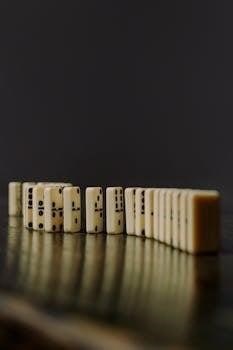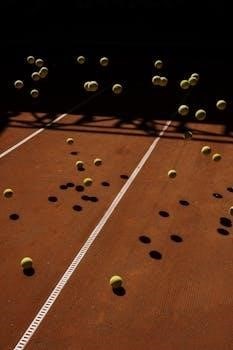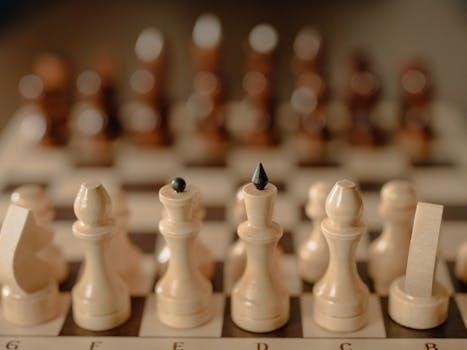
The Game of Life is a classic board game simulating life’s journey. Players make choices about career, family, and investments. The goal is to accumulate the most wealth by the end, experiencing life’s ups and downs along the way.
Overview of the Board Game
The Game of Life board game presents a colorful and engaging journey from start to retirement. Players navigate a game board filled with various spaces representing life events and choices; The game involves spinning a wheel to determine movement and drawing cards that present unexpected situations. Players choose paths, like college or career, and make decisions about family, homes, and investments. The board is designed with plastic structures and a spinning wheel, creating an interactive experience. Throughout the game, players accumulate money and aim to manage debt wisely. This board game is designed for families and friends to enjoy the rollercoaster of life.

Gameplay Mechanics
Gameplay in The Game of Life involves moving a car token around the board using a spinner. Players encounter various spaces triggering life choices, drawing cards, and managing finances to win.
Setting up the Game Board
To begin a game of The Game of Life, the first step involves carefully assembling the game board. This often includes attaching plastic superstructures, such as buildings and mountains, to the main game board. Ensure the four-part wheel of fortune, also known as the spinner, is properly placed and ready to use. If your game includes a sticker sheet for bridges and mountains, apply those according to the instructions. The ‘Spin to Win’ strip should also be placed on the board. Then, separate the various decks of cards ⸺ House, Action, Career, College Career, and Pet ⸺ and place them face down in designated areas around the board. Finally, organize the play money, credit bills, and LIFE tiles for easy access during gameplay. Each player should choose a car token and gather the corresponding colored pegs, and ensure they are ready to embark on their journey through life.
Moving the Car Token and Spinner
In The Game of Life, movement around the board is determined by spinning the wheel of fortune, which dictates the number of spaces a player moves their car token. Each player starts at the ‘Start’ space and takes turns spinning and moving along the designated path. The path is marked with various action spaces and life choices, leading to different outcomes. After spinning, players must move their car token the exact number of spaces shown on the spinner, no more, no less. This movement is crucial as it will determine the actions they must take and the consequences they will face, such as career choices, family additions, or monetary gains and losses. Players continue to move around the board, navigating its twists and turns until they reach retirement, which marks the end of the game.
Life Choices and Milestones
The Game of Life is centered around making key life choices and experiencing milestones, simulating the unpredictable nature of real-life journeys. Players encounter various options, such as choosing a career path, whether to pursue college, or opting to start a family. These decisions directly influence their progress and the financial outcomes they experience throughout the game. Milestones, such as buying a house, getting married, or adopting pets, also shape the player’s path, adding complexity and unique challenges. Each choice impacts their accumulated wealth, influencing their final score. Navigating these milestones and choices strategically is crucial for achieving success in the game, mirroring the importance of decision-making in life. These choices ultimately determine a player’s unique path through the game and their final financial standing.
Career and College Paths
In The Game of Life, players face a pivotal early decision⁚ whether to pursue a college education or begin a career directly. The college path usually involves incurring debt but often leads to higher-paying career options later in the game, reflecting the long-term investment in education. Alternatively, starting a career immediately provides an earlier income stream, though potentially with lower earning potential. Career choices range from traditional professions to more creative or adventurous roles, influencing the player’s financial trajectory and the overall game experience. These choices require careful consideration of risk versus reward, simulating the real-life trade-offs involved in career planning and education. The chosen path significantly shapes the player’s journey and the opportunities they encounter throughout the game, demonstrating the significance of these early decisions in life.
Key Elements of the Game
The game incorporates LIFE tiles, action spaces, and various cards. Managing money and debts is vital, while the “Spin to Win” feature adds an element of chance. These aspects drive gameplay.
The Role of LIFE Tiles
LIFE tiles are a crucial element in The Game of Life, each holding a secret message revealing a special achievement and a corresponding dollar amount. These tiles are collected throughout the game as players navigate various life events and milestones. The monetary value on the LIFE tiles contributes to a player’s total wealth at the end of the game. These tiles represent significant life moments, such as getting married, having children, or achieving career goals. They add an element of surprise and reward, making the game more engaging and unpredictable. Players strategically try to collect more valuable LIFE tiles to gain an advantage over their opponents, as they are a key factor in determining the winner. Therefore, acquiring a good selection of LIFE tiles is essential for success.
Action Spaces and Cards
Action spaces on the game board trigger the drawing of Action cards, introducing unexpected events and challenges into the game. These cards can result in a wide range of outcomes, from earning large sums of money to incurring significant expenses. For instance, players might receive a reward for writing a book or face a costly expense for traveling the world. Landing on an Action space adds an element of surprise, forcing players to adapt to the circumstances presented by each card. These cards often require players to make choices that impact their finances and game strategy. They are designed to mimic the unpredictable nature of life, adding a layer of excitement and making each game unique. The consequences of action cards can be either beneficial or detrimental, emphasizing the importance of making wise decisions.
Managing Money and Debts
Effective money management is crucial in The Game of Life, as players navigate through various life stages and make financial decisions. Players earn income through salaries, payday spaces, and certain action cards. However, they also encounter expenses such as buying houses, paying taxes, or facing unexpected costs from action cards. Taking out loans is an option when funds are low, but these debts must be repaid at the end of the game, affecting overall wealth. Strategically spending money on investments like houses and managing debts carefully is key to success. This aspect of the game emphasizes the importance of financial responsibility and planning for both immediate needs and long-term goals. Balancing income and expenses is vital for accumulating wealth and avoiding financial ruin by the game’s end.
Spin to Win Feature
The Spin to Win feature in The Game of Life introduces an element of chance and excitement, providing players with opportunities for additional rewards or setbacks. This feature typically involves landing on specific spaces on the game board and using tokens or markers to take part. When activated, players spin a separate wheel or use a designated spinner to determine their fate. The results can vary greatly, from winning significant amounts of money to facing unexpected financial losses. The Spin to Win feature adds unpredictability to the game and can drastically alter a player’s financial standing, making it a critical component of the overall gameplay. It encourages risk-taking and adds an extra layer of strategy. Players must weigh the potential rewards against the possible risks. This feature embodies the unpredictable nature of life.

Winning the Game
The Game of Life concludes when all players reach retirement. The winner is determined by calculating each player’s total wealth, including cash on hand, assets and subtracting any debts. The player with the most money wins.
Retirement and Calculating Wealth
The culmination of The Game of Life arrives when all players reach the designated retirement space on the game board. This marks the end of the active gameplay and the beginning of the final scoring phase. Players must first settle any outstanding debts, such as bank loans, that they may have accumulated during their journey through life. Once debts are paid, players calculate their total wealth. This calculation involves adding up all their cash on hand, the value of any assets they may have acquired, and the value of any LIFE tiles they collected. The player who amasses the highest net worth, after debts are subtracted from total assets, is declared the winner of the game. This process emphasizes strategic financial management throughout the game, as prudent spending and investment choices play a crucial role in determining success.

Variations and Editions
The Game of Life has seen many variations, including the “My Dream Job” edition, which lets kids choose unique careers. Other editions offer different themes and customizations, adding variety to the gameplay.
The Game of Life My Dream Job Edition
The Game of Life My Dream Job Edition offers a unique twist on the classic game, featuring careers chosen by kids, for kids. In this version, players can pursue exciting and imaginative professions such as a video game designer, a firefighter, or even a secret agent. This edition empowers kids to make their own decisions and go on fun adventures based on their dream jobs. The game emphasizes experiencing life’s key moments while making independent choices, and it adds an extra layer of engagement by incorporating careers that resonate with children. Players can decide whether to take the longer college path for a higher paying job, or start working sooner, making choices about creativity and helping others. The game is designed to be easy to set up, quick to play, and enjoyable for the whole family, letting players live the life they desire.
Other Editions and Customizations
Beyond the standard version, The Game of Life has several editions and customizations that offer unique gameplay experiences. For instance, the “Greatest Generation” edition incorporates different historical eras and cultural elements. There’s also a “TripAdvisor Edition” that focuses on travel and adventure. These variations often include unique cards, board designs, and even gameplay mechanics to fit their specific themes. Some editions might incorporate modern elements, like updated career paths or technology-related events. Additionally, players can sometimes customize their own games by creating house rules or using expansion packs. These custom options enhance replayability and provide opportunities to tailor the game to specific preferences. The variety ensures that The Game of Life remains engaging and relevant for different audiences and play styles.

The Cellular Automaton “Conway’s Game of Life”
Conway’s Game of Life is a zero-player cellular automaton, not a board game. It uses simple rules on a grid to simulate life and death of cells based on neighboring cells.
Basic Rules of Conway’s Game of Life
Conway’s Game of Life operates on a two-dimensional grid of cells, each of which can be either alive or dead. The game evolves in discrete time steps, or generations, according to a set of simple rules. A live cell with fewer than two live neighbors dies, due to underpopulation. A live cell with two or three live neighbors survives to the next generation. A live cell with more than three live neighbors dies, due to overpopulation. Finally, a dead cell with exactly three live neighbors becomes a live cell, due to reproduction. These rules, applied simultaneously to every cell on the grid, determine the next state of the game and create complex patterns and behaviours from a simple starting point.